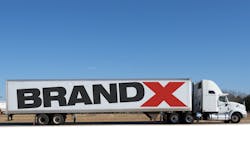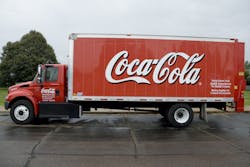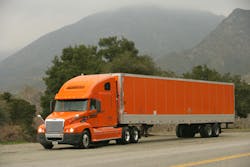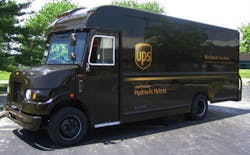Don't be Brand X
To be sure, every business is represented— if not outright personified— by a brand.
The beauty of a brand is in the eye, the ear, even the emotions of those of its intended audience whenever they engage with it.
That’s why businesspersons ignore the power of the brand at their peril.
Brands have been around since the first head of cattle got scorched with one. Over time, branding morphed from marking ownership to representing a commercial venture.
By the mid-20th century, the art and science of branding to attract and retain customers had advanced to the point where buyers were forming dynamic relationships with the brands that best “spoke” to them, a phenomenon which continues to this day.
Despite how much nearly everyone interacts with brands in their everyday lives, it can be argued that many fleets don’t benefit fully or at all from branding— a strategy proven over decades and across the globe to be incredibly effective at attracting and keeping both valued customers and employees.
Yet, according to what experts in the field tell Fleet Owner, a properly executed brand will project the value inherent in what a fleet offers, enabling it to capture more of the customers and employees it wants to secure— as well to charge more for its services compared to its poorly branded competitors.
Committing to a consistent brand strategy will grab and hold the attention of those coveted customers who see beyond rates and those employees who enhance a company with their skills and attitude.
“If you are not a brand, you are a commodity,” marketing guru Philip Kotler famously observed. “Then price is everything and the low-cost producer is the only winner.”
In other words, don’t be Brand X. Don’t be the fleet that every desired customer’s gut tells him is the one offering nothing more than standard service at perhaps a palatable price. And don’t be the fleet that every quality driver, or any type of sought-after employee, passes up as a run-of-the-mill outfit.
Be the fleet that fields a brand that communicates that it delivers something above and beyond the merely ordinary. Be the fleet that regards its brand as a conceptual structure that—once brought roaring to life—will power it outside the constraining boxes of margin-pricing and driver churn that limit so many trucking operations.
The first thing to know is what a brand is. And what it is not. A brand is not a logo or a tagline. Those are crucial elements of branding, but only as means for communicating the actual brand.
A brand, on the other hand, is the tangible and intangible embodiment of that certain something that uniquely benefits the customers and employees of a business. It defines what your business is truly about and what distinguishes it from the competition.
Thomas J. Watson Jr. (1874-1956), who was credited with transforming IBM into a global giant, aptly captured branding’s value proposition when he remarked that, “Quality in a service or product is not what you put into it. It is what the client or customer gets out of it.”
Indeed, Shanna Columbus, chairman & CEO of Louisville-based PriceWeber, defines a brand as “a promise—it exists as an idea in the mind of your audience, reflecting what they think of your company, product or service.
“A brand runs much deeper than the external look or polish you give it,” she continues. “It informs how you interact with your customers and employees. Its message should be measured against what you stand for and that should drive company policies.”
Patrick Byers, founding partner of Seattle-based Outsource Marketing, views a brand “not as what it ‘says’ to you, but what you feel emotionally when you come in contact with an organization. It could be a positive response that pulls you in or a negative one that turns you away.”
Subliminal shortcut
Byers says a brand must function as a “subliminal shortcut through the information overload that makes it so hard to process all the messages coming at us.” He explains that a fleet “competes against all the daily interruptions distracting the attention of your customers’ ‘knowledge workers’ as they decide on freight service. That means you’re not only going up against all the other brands in trucking, but all those outside their work world too.”
“Think of your brand as the message that projects your business strategy into the marketplace,” she continues. “A brand is not something dreamed up by a consultant; it should be authentically drawn from the DNA of the culture, which perhaps may extend back to the company’s founder.”
“Branding is all about putting forward what your niche is or what you stand for— what it is that uniquely differentiates you from the competition—and then communicating it effectively,” remarks Susan Fall, president of San Diego-based LaunchIt Public Relations. “If it’s not presenting a singular service you provide, then it must be about what value sets you apart, such as being efficient or innovative.”
According to Tony Beard, president & chief creative officer of PriceWeber, branding is “not only about differentiation, but also positioning. The three different positions most companies can take with their brands are to present themselves as being the low-priced competitor or being the best in the business—although not necessarily the most expensive—or being somehow different or unique. And some brands combine being the best and the unique offering.”
“Since the brand should speak to customers and employees,” advises Caroline Lyle, owner of Nashville-based Torque Marketing Group, “start by putting together a mission statement that defines how those audiences will benefit from the company. That will spell out for both owners and employees who it is they serve and how they do it.”
Fall concurs with that suggestion, noting that the “brand should go hand-in-hand with the fleet’s business plan and/or mission statement, which are usually shelved at some point but should be viewed actively by management. The brand promise can be derived from that document. And it must be clear and concise. A fleet will want its brand to speak to customers and drivers, but both those audiences want to be associated with a fair, secure and safe operation.”
Positive connection
Therefore, a solid, well-crafted brand should connect positively with everyone the fleet wants to interact with across the board, including clients, employees, business and civic leaders, and government regulators, for that matter.
“The key step in branding is to understand what your customer is looking for,” remarks PriceWeber’s Columbus, “as well as to learn how they view your company. A fleet will be seen in terms of a value they deliver on, such as being reliable or dependable. Starting from there, the brand should be composed of all the positive experiences around it for the customer.”
Ohlin advises that to work up a brand, first get at what the company is truly about by extensively interviewing those inside the company—“from top to bottom”— as well as customers and prospects about its performance to accurately gauge how the operation is widely perceived.
As she sees it, internal and external research will reveal what value a brand is delivering and if there are any disconnects between how top management and others perceive the brand. “The value expressed by a brand can be an intangible, such as trustworthy or reliable, whatever is delivered that goes beyond meeting the table stakes expected by customers and employees,” she explains.
Ohlin suggests avoiding “branding the obvious about your company because it will make the brand feel unprofessional. You also want to get a bead on the branding efforts of competitors to avoid being grouped with them in the customer’s eyes. A brand must be specific in terms of identifying your company for what it can do that no competitor can.”
“Be consistent with the branding message across everything—your logo, your equipment, your website, even how your employees represent your business,” remarks LaunchIt’s Fall.
“Keep in mind that these days it’s tough to brand without being creative enough to break through the wall of indifference people put up to all the commercial messages aimed at them,” remarks Torque Marketing’s Lyle. “The brand always needs to be supported with a logo and tagline, and these must be presented consistently to get it to stick, whether through collateral materials, publicity, advertising and, of course, social media.”
Cut through
The key is to cut through all the clutter by developing a brand that has meaning to it,” advises Outsource Marketing’s Byers. “You must be able to articulate a unique and meaningful position in your specific marketplace.”
Byers says to next assess what’s happening in your business to, for example, avoid branding in a segment that is dropping off, as well as conducting customer research on how your fleet is viewed and how decisions on selecting freight service are made.
From there, he says to delve into your company’s culture to establish what your brand’s positioning and messaging will be. “The cornerstone of your brand is built on what you are, who you are for, how you are different, and why all that matters,” Byers contends. “Examine all these areas and you will end up with a 360-deg. view of the brand.
“What you’re after,” he continues,” is to present a meaningful differentiation that can drive decision-makers to stay with or switch to your brand. For example, if every fleet in the category is ‘on time,’ then branding around that is not meaningful.
“The real payoff for all this comes as customers engage with your brand over time,” he relates. “A powerful brand will help create and captivate the customers you seek and keep away those you don’t want, such as the ones only after the lowest rate.”
Byers also points out that a brand “must be professional, yes, but also human—that is, approachable and likeable. You want to communicate that your company cares and is passionate about what it does.”
After a fleet has formulated its brand, it will want to preserve its “essence” (core concept), says PriceWeber’s Beard. “Over time, you may choose to update the external look, such as the logo and other indicators,” he explains, “but the brand essence will stay the same as an accurate reflection of your corporate culture.”
Roll out
Once the brand, including its positioning and messaging, are established, Beard advises that it is “not necessary to roll it all out at once, which would be unrealistic except for very small firms. Certainly, a truck fleet can’t strip the logos off or repaint its equipment all at once to display the new brand. By the way, we do like to say ‘a good logo is better than a bad one,’ yet the logo is never as important as what your brand stands for.”’
Beard adds that even once the rollout is under way, the fleet should regard its branding process as continual. “You want to keep on evaluating the brand’s effectiveness and making adjustments to its components perhaps every few years.”
“It is indeed more important to introduce a brand in a practical manner, otherwise it may never get done,” observes PriceWeber’s Columbus. On the other hand, she notes that “if senior fleet executives elect to embark on branding, they will find a way to get it done.”
Certainly, branding can easily be regarded as less than scientific— at least until you start to feel its positive impact on your fleet. Or as Outsource Marketing’s Byers puts it, “Branding occurs at the intersection of logic and magic.”
Nevertheless, bear in mind the practical reality that Torque Marketing’s Lyle points to: “All the effort that can be put into effective branding will be for nothing if the fleet does not follow through on actually delivering on what the brand promises to do—both externally and internally.”
David Cullen is Fleet Owner’ s executive editor.
He can be reached at [email protected] and can be followed via Twitter @David_L_Cullen




